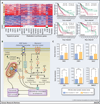The Role of Cholesterol in Cancer
- PMID: 27197250
- PMCID: PMC5813477
- DOI: 10.1158/0008-5472.CAN-15-2613
The Role of Cholesterol in Cancer
Abstract
The roles played by cholesterol in cancer development and the potential of therapeutically targeting cholesterol homeostasis is a controversial area in the cancer community. Several epidemiologic studies report an association between cancer and serum cholesterol levels or statin use, while others suggest that there is not one. Furthermore, the Cancer Genome Atlas (TCGA) project using next-generation sequencing has profiled the mutational status and expression levels of all the genes in diverse cancers, including those involved in cholesterol metabolism, providing correlative support for a role of the cholesterol pathway in cancer development. Finally, preclinical studies tend to more consistently support the role of cholesterol in cancer, with several demonstrating that cholesterol homeostasis genes can modulate development. Because of space limitations, this review provides selected examples of the epidemiologic, TCGA, and preclinical data, focusing on alterations in cholesterol homeostasis and its consequent effect on patient survival. In melanoma, this focused analysis demonstrated that enhanced expression of cholesterol synthesis genes was associated with decreased patient survival. Collectively, the studies in melanoma and other cancer types suggested a potential role of disrupted cholesterol homeostasis in cancer development but additional studies are needed to link population-based epidemiological data, the TCGA database results, and preclinical mechanistic evidence to concretely resolve this controversy. Cancer Res; 76(8); 2063-70. ©2016 AACR.
©2016 American Association for Cancer Research.
Conflict of interest statement
Figures


References
-
- Krycer JR, Brown AJ. Cholesterol accumulation in prostate cancer: a classic observation from a modern perspective. Biochimica et biophysica acta. 2013;1835(2):219–229. - PubMed
-
- Allott EH, Howard LE, Cooperberg MR, Kane CJ, Aronson WJ, Terris MK, et al. Serum lipid profile and risk of prostate cancer recurrence: Results from the SEARCH database. Cancer epidemiology, biomarkers & prevention : a publication of the American Association for Cancer Research, cosponsored by the American Society of Preventive Oncology. 2014;23(11):2349–2356. - PMC - PubMed
Publication types
MeSH terms
Substances
Grants and funding
LinkOut - more resources
Full Text Sources
Other Literature Sources
Medical

